It’s probably not most people’s idea of the perfect working environment. But when Dr Eric Schmieman looks out of his office window towards the ravaged reactor of Chernobyl’s infamous power station, he sees a project that he describes as the most technically rewarding of his life.
Schmieman, a civil engineer from Pacific Northwest National Laboratory in the US, is currently senior technical advisor on what might well be one of the challenging and impressive engineering projects in the world today, the €1.5bn international effort to clean up the remains of mankind’s worst nuclear accident.
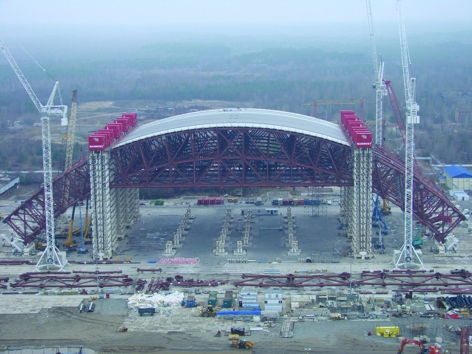
Known as the Shelter Implementation Plan (SIP), the project is funded through the European Bank for Reconstruction and Development (EBRD) by 46 different countries and organisations. Since 1998, the engineers involved have worked their way through a long list of onerous challenges (see box), from stabilising the crumbling sarcophagus that was hastily erected following the 1986 disaster, to building the office blocks and associated infrastructure essential for such a long-running initiative.
But the SIP’s crowning glory - is, without a doubt, the construction of the New Safe Confinement (NSC) - an immense steel arch, designed to last for 100 years, that will protect the sarcophagus from the elements, and enable engineers to safely and methodically tidy up a nuclear legacy that has troubled the world for the past 27 years.
Standing 110m high, 250m wide, 150m long and weighing in at 30,000 tonnes, the NSC is currently being assembled 600m away from the damaged reactor where, thanks to the remediation work of the past two decades, the relatively low ground-level radiation dose levels enable engineers to work for upto 40 hours a week. If all goes to plan, at some point in 2015 the shelter will briefly become one of the largest moving structures on land as engineers begin carefully sliding it along vast tracks to its final resting place.
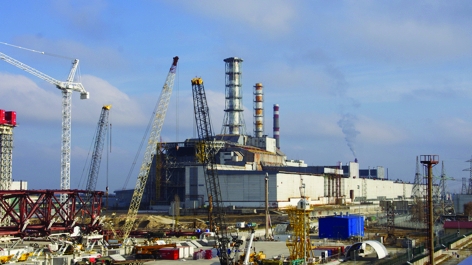
Given that Ukrainian authorities have deemed the 30km exclusion zone around Chernobyl won’t be completely safe for another 20,000 years it’s perhaps surprising to learn that it’s safe to work at the site. But according to Schmieman the dose levels in the so-called “erection zone” are lower on the ground than those that he would experience in his office back in Washington state, where the local geology is responsible for far-higher doses of background radiation.
Nevertheless, Chernobyl remains an exceptionally hazardous place. Many areas within the facility are completely sealed off, and dose rates close to the reactor are extremely high. ‘The hazard increases as you get closer to the source and it’s a deadly hazard if you get close enough,’ said Schmieman. Little wonder that a remote assembly technique was viewed as so attractive.
But this approach, though extremely elegant, doesn’t completely solve the problem. Because even 600m from the reactor, the dose rate increases at higher elevations.
To address this problem, the engineering team has developed an innovative erection process which ensures that workers need never stray above the 30m mark.
‘The highest part of the arch is constructed first (roughly the top one third),’ explained Schmieman. ‘We then attach some legs to that, which are the next part down. The structure is then jacked 30m into the air, the legs swing in and are tied together to prevent them from spreading out flat. We remove the jacks, add another pair of legs, jack that up another 30m and the process is repeated until we get the arch structure 110m up in the air.’
The jacks used to lift the arch are mounted on 10 specially built towers. Each tower has 52 cables hanging down, and each cable has a small hydraulic unit that is able to latch on, move a short distance, and lock itself in place. These can all be controlled to within a fraction of a mm, and are carefully controlled to move at precisely the same time in order to lift the arch correctly.
Intriguingly, though most of the systems and equipment used to assemble the NSC are bespoke, the jacks have been used once before: to raise sunken Russian nuclear submarine the Kursk from the bottom of the Barents sea in 2001. ‘They haven’t had any use for these things since then,’ commented Schmieman, ‘It really puts into perspective how often engineers get to do something like this.’
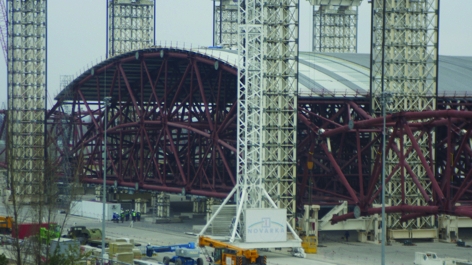
Work is now well under way on the structure. Last November, the first segment of the arch was lifted to an interim height of 22m and with the end of the harsh Ukrainian winter now in sight, Chernobyl’s international team of engineers is preparing to return.
This spring, further sets of legs will be added until half of the arch is complete. Work will then begin on the identical second half of the arch, and ultimately the two halves will be bolted together.
With the main structure assembled, the team will then turn its attention to the inside of the shelter, and the numerous systems and tools that will keep it safe and enable engineers to begin the deconstruction of the reactor.
Perhaps the most impressive of these is a giant overhead crane that will be attached to the underside of the shelter roof.
Known as a bridge crane - after the 96m long moving bridges that straddle six parallel tracks mounted to the NSC’s ceiling - this enormous machine, which will be wirelessly remotely operated, is currently being manufactured by US industrial robotics specialist PaR.
The crane has three different carriages - or primary tools: a so-called classic carriage which features a hook on a cable that can be raised or lowered by a single drum; a secure carriage, which uses two drums, and will be used to move people around the shelter inside a shielded box; and a custom-made tensile truss system known as the mobile tool platform (MTP).
The industrial equivalent of the complex cabling systems that enable TV cameras to swoop above the action of major sporting events like the Olympics, the MTP will be used to used to move tools and robotic devices in any direction within the shelter.
The device - said to be the largest of its kind ever built - will consist of two triangular platforms connected by six cables, two on each corner of the triangle. Whilst the design ensures that the platform is absolutely still and rigid, hoists on the upper triangular platform enable the lower platform to be raised and lowered to the working area. Thus, a host of robotic devices - such as grippers, drills, crushers, and saws, can be moved precisely into areas off-limits to people.’
Once the crane is in place the NSC will be moved into its final resting position around 600m away, a process that Schmieman anticipates taking around two days.
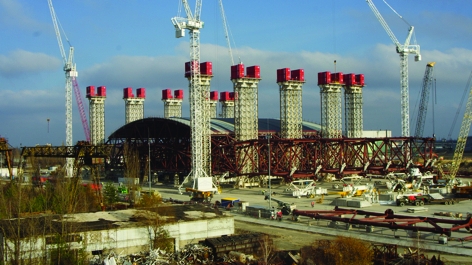
The giant tracks along which the shelter will be moved are themselves a huge engineering achievement.
At each end of the tracks - in the erection zone and in the final resting position (known as the service zone) - around 400 huge piles have been driven 26m into the ground. In the area in between these two zones there are no piles but instead a spread foundation that rests on the ground top. This is because, whilst the erection and service zones will experience prolonged horizontal reaction forces, the shelter will pass relatively quickly over the area in between.
On top of these foundations sit the rails along which the NSC will slide on specially developed Teflon bearing links. 17m wide and the height of a two-story building, these vast concrete structures are topped with a stainless steel plate, mounted at a specific angle to ensure that the shelter can be accurately positioned.
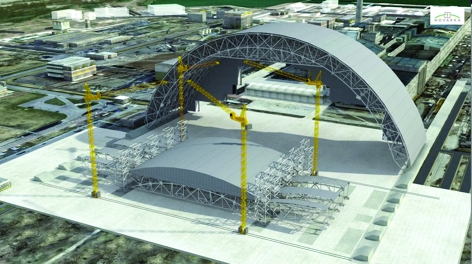
‘People ask How do you slide this thing?’ said Schmieman, ‘There’s 30,000 tonnes of structural steel, it must take a lot of energy to get this going. But we’ve reduced friction enough that our concern is not about how we get it going, it’s how do we stop it, and how do we prevent it from moving before we want to because there’s a huge surface area for the wind to act on here.’
To achieve this the shelter is fitted with a hydraulic pawl and ratchet system - powered by diesel electric generators hung from the arch - that carefully moves the shelter along the rail and prevents it from running out of control.
‘These devices have to be perfectly coordinated,’ said Schmieman, ‘this thing is 250m wide, we don’t want to get one side going faster than the other, just a small deviation would stop you form going any further’
Once the NSC reaches its final resting place, the Teflon bearing pads are removed, and the weight of the structure will hold it in position.
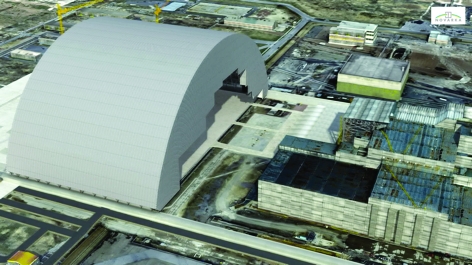
With the shelter designed to remain in place for at least 100 years, a host of monitoring and control systems will help to keep it safe and reduce the need for regular maintenance. And Schmieman’s team has devised a particularly elegant solution to the problem of corrosion.
‘There are quite a few steel structures in the world that have already lasted 100 years,’ he said. ‘The one that comes instantly to mind for most people is the Eiffel Tower. They’re continually repainting the Eiffel tower because that’s the cheapest thing to do, but we can’t do that because of the hazard of the radiation dose rates up close to the reactor.’
Instead, the outside of the shelter’s tubular steel structure is protected from corrosion by an air-conditioning system that circulates through the 12m space between the shelter’s tubular steel structure and its stainless steel cladding.
This air is blown into the gap through large dessicant dryers, which remove moisture for the air and maintain it at less than 40 per cent humidity, a condition under which carbon steel will not corrode. This system recirculates around 45,000 m3 of air per hour, at a pressure around 50 pascals higher than the outside air to prevent areas of stagnation developing inside.
The system also heats the air in the annular space to a temperature around 3°C warmer than the air inside the shelter. Incredibly, the NSC is one of a handful of buildings that will enclose a volume of air large enough to create its own weather. But by maintaining a temperature difference between the upper surfaces and the air within, condensation, and the prospect of “rain” falling on the shelter’s radioactive contents, will be avoided.
Given the shelter’s hazardous contents, its designers have also equipped it with technology for monitoring both Seismic activity and radiation levels.
Designed to withstand and survive earthquakes measuring 6 on the MSKscale (which is still widely used in Russia and former Soviet states) the facility is bristling with seismic moniotoring equipment. ‘We have a system of about 6 seismic monitoring stations in and around the site - as well as accelerometers and strain gauges mounted on the structure so that we’ll be able to see how it responds to any ground motion,’ explained Schmieman.
It’s a capstone project. For a lot of engineers this must be like the guys who worked on the pyramids, you can’t think of working on anything much bigger than this.Eric Schmieman
Special attention has also been given to developing techniques for monitoring the spread of radiation through the shelter. For this, explained Schmieman, the team enlisted the help of architects, who’s skill at analysing and predicting how people will move through the shelter has enabled the team to identify the critical areas for radiation monitoring. Schmieman added that the shelter is also equipped with hundreds of sensors for detecting radioactive dust stirred up the activity within the shelter. ‘We have to monitor the air for suspended dust particles, and the bottoms of people’s shoes and their hands.’
Once the shelter has been commissioned, the SIP project is formally over, and what happens then to the contents of the New Safe Confinement will be largely down to the Ukrainian authorities.

Currently, Ukraine has no permanent facility for high-level nuclear waste storage, so it seems probable that that the hazardous material will remain where it is for some time to come.
But critically, the shelter will buy the authorities time, and give them the opportunity to finally approach Chernobyl’s hazardous legacy in a methodical fashion. ‘The point is’ said EBRD Deputy Director Balthasar Lindauer, ‘once the NSC is in place, we’re not dealing with an emergency situation any more. Things can be done in a calm, well-prepared and organised fashion.’
Whatever happens - and both Lindauer and Schmieman acknowledge that the facility might well outlive its 100 year life span - Chernobyl’s giant new shelter is an undeniably phenomenal engineering achievement: the elegant result of an international collaboration, and an application of innovative technology on a monumental scale. ‘It’s a capstone project,’ commented Schmieman, ‘for a lot of engineers this must be like the guys who worked on the pyramids, you can’t think of working on anything much bigger than this.’
The shelter implementation plan (SIP)
The NSC is the most expensive and final stage in a project which began back in 1998: the €1.5bn Shelter Implementation Plan (SIP).
Before they could begin designing and building the New Safe Confinement, the engineers involved had to work their way through a list of over 22 separate projects.
‘When we began this work the Ukraine really lacked the infrastructure to take on anything like this,’ said Schmieman, ‘they didn’t have banking institutions, and private companies that could bid on a request for proposals. We also had to build physical infrastructure at the site. We built training centres to train the workers so they could work safely, we had to build office buildings, bring internet access and roads to the site and also clean up some areas.’
The biggest project to date has been stabilising the Sarcophagus, or “Object Shelter”, that was hastily built around the damaged reactor following its explosion on 1986. This has helped ensure that when the new shelter is in place, the engineers are able to dismantle the reactor in a controlled manner. ‘The main purpose of the NSC confinement is to take apart the destroyed reactor and its surroundings in an orderly fashion,’ said Schmieman. ‘If it were to be a disorderly pile of rubble, the cost in terms of radiation exposure to humans and the cost in dollars would be much, much greater.
Read more about the hazardous nuclear legacy of the Soviet era here
New Safe Confinement - The Data
- Cost - roughly €1 billion
- Weight - 30,000 tonnes
- Height - 110m
- Width - 250m
- length - 150m




April 1886: the Brunkebergs tunnel
First ever example of a ground source heat pump?